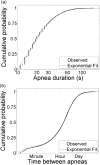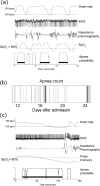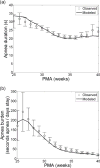Stochastic modeling of central apnea events in preterm infants
- PMID: 26963049
- PMCID: PMC5293178
- DOI: 10.1088/0967-3334/37/4/463
Stochastic modeling of central apnea events in preterm infants
Abstract
A near-ubiquitous pathology in very low birth weight infants is neonatal apnea, breathing pauses with slowing of the heart and falling blood oxygen. Events of substantial duration occasionally occur after an infant is discharged from the neonatal intensive care unit (NICU). It is not known whether apneas result from a predictable process or from a stochastic process, but the observation that they occur in seemingly random clusters justifies the use of stochastic models. We use a hidden-Markov model to analyze the distribution of durations of apneas and the distribution of times between apneas. The model suggests the presence of four breathing states, ranging from very stable (with an average lifetime of 12 h) to very unstable (with an average lifetime of 10 s). Although the states themselves are not visible, the mathematical analysis gives estimates of the transition rates among these states. We have obtained these transition rates, and shown how they change with post-menstrual age; as expected, the residence time in the more stable breathing states increases with age. We also extrapolated the model to predict the frequency of very prolonged apnea during the first year of life. This paradigm-stochastic modeling of cardiorespiratory control in neonatal infants to estimate risk for severe clinical events-may be a first step toward personalized risk assessment for life threatening apnea events after NICU discharge.
Conflict of interest statement
JBD and HL have filed for a patent on the apnea detection algorithm.
Figures








References
-
- BARRINGTON KJ, FINER NN. Periodic breathing and apnea in preterm infants. Pediatr Res. 1990;27:118–21. - PubMed
-
- BAUER J, JANECKE A, GERSS J, MASJOSTHUSMANN K, WERNER C, HOFFMANN G. Circadian variation on oxygen consumption in preterm infants. J Perinat Med. 2009;37:413–7. - PubMed
-
- BAUM LE, PETRIE T, SOULES G, WEISS N. A Maximization Technique Occurring in Statistical Analysis of Probabilistic Functions of Markov Chains. Annals of Mathematical Statistics. 1970;41:164–&.
-
- CHAITIN GJ. Randomness and Mathematical Proof. Scientific American 1975
Publication types
MeSH terms
Grants and funding
LinkOut - more resources
Full Text Sources
Other Literature Sources
Medical
